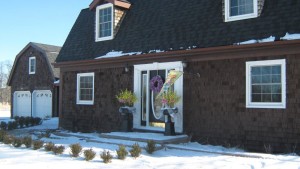5 Tips for Finding Winter-Ready, Energy Efficient Windows
 Aged, outdated windows can account for 10-50% of your home’s energy bills during the winter months if they’re guilty of letting heat escape. Control costs and maximize thermal efficiency by installing energy efficient windows designed to keep the warm air in and the cold air out.
Aged, outdated windows can account for 10-50% of your home’s energy bills during the winter months if they’re guilty of letting heat escape. Control costs and maximize thermal efficiency by installing energy efficient windows designed to keep the warm air in and the cold air out.
Here are the important attributes of energy efficient windows that will keep you and your home cozy all winter long:
1. Double- and Triple-Paned Windows
Single-paned windows are poor insulators. To achieve better thermal performance and keep your home warm during those chilly winter months, you’ll want to layer up:
- Double-paned windows can reduce heat loss by up to 50%, maximizing thermal efficiency and keeping your energy bills in check.
- Triple-paned windows have even higher energy ratings, further reducing heat loss and sound penetration, though they are more expensive and heavier.
Consult with an expert to help you decide on the windows that will best suit your home and fit your needs.
2. Inert Gas Fillings between Window Panes
Slow moving, minimally conducive gas fills improve the thermal efficacy of double- or triple-paned windows, allowing them to perform better in cold temperatures.
The most common gases used are:
- Argon: Non-toxic, clear, odourless, and inexpensive, its thermal conductivity is roughly 67% compared to air. Argon is commonly used for double-paned windows.
- Krypton: Although a better insulator than argon, it is more expensive to create. Krypton is often used for triple-paned windows (and will help Superman-proof your home).
In some cases, manufacturers will use a combination of argon, krypton, xenon, and nitrogen.
3. Low U-Factors and High R-Values
The U-Factor measures heat transfer or loss through a specific material or product (the rate at which a window or door conducts non-solar heat flows). Lower U-Factors mean decreased heat loss and enhanced insulation. As a general rule, the more panes of glass a window has, the lower its U-Factor will be.
The R-Value is the U-Factor’s inverse twin, measuring defence against thermal conductivity or heat loss. Look for windows with higher R-Values to guarantee maximum energy efficiency and resistance to heat loss.
With both U-Factors and R-Values, make sure the information provided is for the whole window, not just the centre.
4. Energy Star Ratings
To achieve an ENERGY STAR certification, windows need to exceed strict performance requirements tailored to specific climates. If the products pass, they’re separated into zones.
According to ENERGY STAR, Southern Ontario falls into Zone B. That means you need to select windows certified for Zone B or colder. Choosing windows rated for warmer environments (Zone A) means they will perform poorly and will not keep your home warm.
5. The Right Window Frame
When it comes to keeping warm and maximizing energy efficiency, choosing the right window frames matters. Non-metal frames (wood, vinyl, or fiberglass) will be less conductive and have lower U-Factors than their metal counterparts (like aluminum).
Many manufacturers will use warm edge spacers between layers of double- or triple-paned windows to reduce conductivity, condensation, and heat transfer. Contact your contractor or manufacturer to find out what kind of spacer will be used in the windows you’re ordering.
Other Steps You Can Take to Keep Warm this Winter
- Ensure your windows – old or new – are properly weatherized: Make sure caulking is in good condition. If it’s aged, remove it gently, and then wash the area before re-applying new caulking. When choosing weather stripping, it should form an airtight barrier without making it difficult to close or lock the window.
- Use quality curtains, drapes, and blinds: Keep your window coverings drawn during the night to defend against chilly drafts, but make sure they’re open during the day to let warm sunlight in.
Looking Beyond the Glass – Is Your Home Ready for Winter?
Faulty windows might not be the only things impacting your home’s heating and energy bills. Inspect your exterior walls – whether vinyl siding, wood, or cement – for signs of cracks, discolouration, or evidence of water penetration.
You can also check your roof for missing, peeling, or cracked shingles and remove debris from gutters to get your whole home ready for winter.
If you suspect problems, contact a trained professional to investigate the issues, recommend appropriate solutions, and conduct quality workmanship to get them fixed fast.
At Quality Exteriors, we are experts at helping you find the ENERGY STAR windows that will fit your home and save you money. Contact us today to request a free in-home consultation.
Serving homeowners in St. Catharines, Niagara, Hamilton, Burlington, and Oakville.
Like this? You might also like:
- Drafty? Don’t Lose Money on Leaky Windows and Doors
- Can New Windows Really Save You Money?
- Are Your Home’s Windows Outdated? What You Need to Know about Full Frame Window Replacements
- When to Request an Estimate for Exterior Work - February 26, 2020
- Merry Christmas from Quality Exteriors - December 18, 2019
- Quality Exteriors Listed In Top 3 Window Companies In St. Catharines - December 5, 2019






